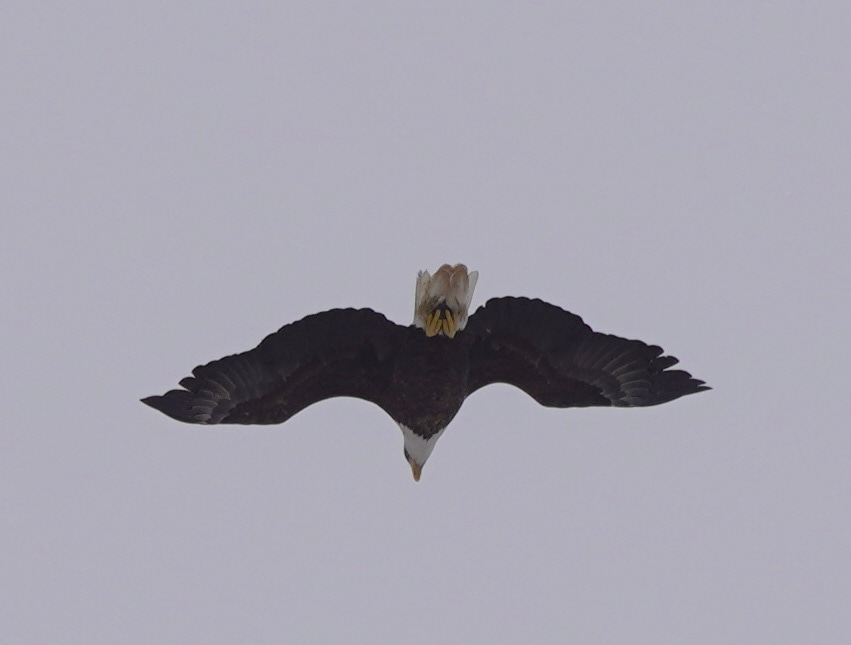A mild winter's impact on an Arctic hawk
Plus, Groundhog Day and a fresh batch of TWiB Notes.
Woodstock Willie was right. This year we have an early spring.
In Illinois, we don’t celebrate that other large marmot out in Pennsylvania. We turn to Woodstock Willie, featured in the film “Groundhog Day,” for our weather forecasts. And Woodstock Willie didn’t see his shadow on February 2. And an early spring arrived last Thursday and Friday with temperatures in the 50s. (Editor’s note: read to the bottom of this newsletter for a photo of me and Woodstock Willie.)
The Mild Winter of 2023-2024 has produced just two cold weeks, which took place in January. Before that time, the weather felt like an extension of fall. Since then, it has felt like early spring.
As if to underscore this, a pair of Red-winged Blackbirds appeared in the nearest wetland on Friday, three weeks earlier than is typical for here. American Tree Sparrows are long gone from the neighborhood.
Rough-legged Hawks are a good gauge as to how cold—or not cold—it has been. Buteos of the high Arctic, Roughies move southward as it gets colder, favoring areas where temperatures remain above minus-10 Fahrenheit but well below freezing. Rough-legged Hawks are one of three North American raptors with feathered legs (hence their name), with Golden Eagle and Ferruginous Hawk being the others—adaptations for staying warm in the cold.
First, let’s take a look at eBird sightings of Rough-legged Hawk in December 2023 for one section of northern Illinois. The blue markers represent sightings.
Just look at what happened when the temperatures dropped in January—most places to the north were well below minus-10 degrees. The red markers represent sightings.
A large number of Rough-legged Hawks moved southward! We only have 10 days or so worth of data for February 2024, but my suspicion is that we’ll be seeing a lot fewer red markers this month.
So, what happens when Rough-legged Hawks stay farther north than usual? It likely brings them in contact with other species in new ways. They may be able to find all the voles they need to get by, but that in turn could affect other predators in the ecosystem, and of course, voles. And here in Illinois we’d have a surplus of those prey items, which has impacts as well.
Birds are resilient, but these unusual weather patterns do have an impact. Many people will be celebrating this early spring in northern climes, and I understand that —roads and sidewalks are free of snow and outdoor activities are much more feasible. But how I wish Woodstock Willie was wrong this year about an early spring.
The road to Prophetstown
Recently I had occasion for some county listing—on the tail end of the January cold spell. County listing is the idea of visiting as many counties as possible and making a list of species observed by county. So I headed about 120 miles west of home to visit some counties that I’d never experienced previously. Any bird sighting in these counties would be a first.
I had some good luck on my first stop, a rural cemetery just off an interstate (cemeteries prove to be great birding locales again). First there was an aforementioned Rough-legged Hawk perched along the road. There were a handful of sparrows, woodpeckers, and corvids. And a few minutes later, a Bald Eagle flew over low in the fog.
Then there was a stop in Prophetstown before a turn south to reach Annawan and Henry County. For every stunner like a hawk or an eagle, there are many more first sightings that are terribly mundane, like the House Sparrows in front of a silo near Hooppole.
My run concluded in tiny Stark County, where I visited the town of Wyoming’s cemetery on hilly ground beside the Spoon River. It was a scenic and charming place, and one I wouldn’t have visited if not for this pursuit. In the end, I added three counties to my list of 71 of the state’s 102 counties.
As promised…
TWiB Notes
Once abundant, the Black-crowned Night-Heron was added to the Illinois Endangered Species List in 1977. Now there is just one breeding colony left in Illinois at the Lincoln Park Zoo in downtown Chicago. Illinois Audubon Society, Lincoln Park Zoo, Bird Conservation Network, Chicago Black-crowned Night-Heron Project and University of Illinois are partnering to sponsor a series of zoom programs to raise awareness and to support ongoing research. A virtual event will be taking place on Feb. 27 at 6 p.m……Birding Magazine contributor and retired diplomat Peter Kaestner recorded his 10,000th species last week when he saw an Orange-tufted Spiderhunter in the Phillippines. That may be the highest total for any birder globally……Chicago Ornithological Society is seeking volunteers for its monthly workday at LaBagh Woods on Feb. 17, starting at 10 a.m. Learn more and sign up here……Flaco the Eagle Owl marked a year of freedom earlier this month after escaping from Central Park Zoo.










Do you have thoughts on Flaco's escape and life in the "wild?" I have been really thrilled to follow his story for the past year, but I am definitely still worried that he will ingest too much rat poison or collide with a vehicle. But... he's had a year of freedom now, so if he did die young, would it have been "worth it?" I find it an endlessly fascinating philosophical question.